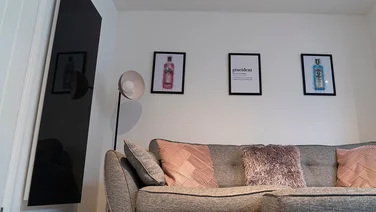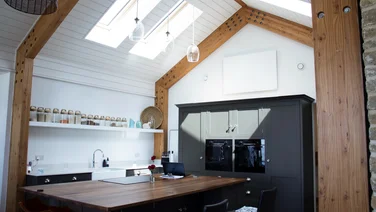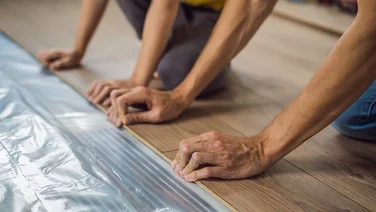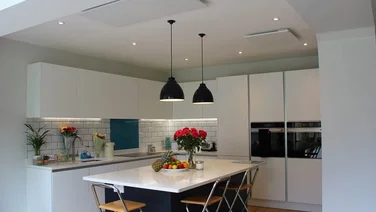- The average cost of infrared heating panels
- Infrared heating panel installation costs
- How much do infrared heating panels cost to run?
- How to save money when buying infrared heating panels
- Will the cost of infrared panels reduce over time?
- Are there any government grants for infrared panels?
- Summary
✔ Expect to spend around £495 per infrared heating panel
✔ Infrared panels for a three-bedroom home costs £7,000, on average
✔ Running an infrared panel will cost you £895 a year
Infrared heating is one of several home heating alternatives to traditional gas-powered boilers. The best part? It doesn’t rely on gas or oil, just electricity.
If you’re considering infrared heating for your home, you’re probably wondering what the costs are. Typically, a single standard infrared heating panel will cost you around £495, but there are other costs involved, too.
To find out more about further costs, including whether we expect them to decrease and what you can do to save, read on.
Want a better idea of how much infrared heating panels will cost you? Find out by using our easy-to-navigate tool. All you have to do is provide a few quick details, and our expert installers will be in touch with free bespoke quotes.
Get free infrared panel quotes
Answer a few quick questions, and our trusted installers will send you bespoke infrared panel quotes – for free.

Image credit: Cürv
The average cost of infrared heating panels
A wall-mounted infrared heating panel costs around £495, and you can expect to spend around £6,000 to heat a whole three-bedroom home – although this will depend on which supplier you go with.
For most homes, you’ll only need around one panel per room. The range in cost is determined by the power of the system, so it’s good to think about the room sizes before you purchase the panels.
These costs can increase if you opt for custom-designed panels, which are infrared heating panels designed to look like, say, a painting or photograph (roughly £540). You can also get infrared panels that function exactly like a mirror, which is perfect for a bathroom!
Some models can reach prices over £1,000, but this is usually for far larger units and isn’t the norm.
Ceiling-mounted infrared heating panels tend to cost a little bit less than wall-mounted panels, clocking in at around £380 per panel. That being said, ceiling panels are generally more efficient (and effective) than wall-mounted ones, so despite the slightly higher initial cost, you’ll get better value for money overall.
Cost of infrared panels by property size
The table below is for wall-mounted infrared panels only:
Of course, these are just averages. If you want a better idea of how much infrared panels will cost for your property, pop a few quick details in this short form, and our trusted installers will get in touch with free bespoke quotes.
Cost of infrared panels by type
The table below is for wall-mounted infrared panels only:

Infrared heating panel installation costs
Installing infrared panels throughout your home costs £6,000, which is quite a bit more than the £3,350 it typically takes to install an electric combi boiler.
It’s a lot simpler to install however. With no pipework it becomes as simple as mounting the system to either the wall or ceiling, then connecting it to the mains electricity.
You can do this yourself without much hassle — infrared heating panels come with stencils that you can use to mark where you’ll drill into your wall.
Then it’s just a case of drill where you’ve marked, inserting screws, and attaching the mounting bracket on the back of the heating panels to the wall.
You’re ready to go as soon as the panel is on the wall and plugged into a mains socket. If you’re still not comfortable doing this, you can hire a professional and expect to pay typical labour costs for installing electrical equipment.
Expect to pay between £350 and £725 to have a professional install the panels throughout your home, depending on the how many you need installed.
It can be a little more complicated installing underfloor infrared heating, but because there is no pipework needed, it is far cheaper than installing water-based underfloor heating.
You also need to think about whether you need more than one panel per room, or if you just need a single, more powerful infrared panel for each room. Use the following calculation to work out how much wattage you need:
Multiply the width and length of a room by the height to get the cubic metres.
Example: L 3m x W 3m X H 2.4m = 21.6m3
Then, multiply the cubic metres of the room by 25 to give you an average wattage required.
Example: room space to be heated 28.8m3 X 25 = 540 Watts
How many infrared heating panels do you need?
You will need between four and five infrared heating panels on average per bedroom, three to four for a typically sized living room, and one or two per bathroom.
It’s still a good idea to work out the size of each room as this will determine how many panels you’ll need — and how powerful they should be.
Your home’s age and insulation levels play a part too, as the older a property is and how well it’s insulated will affect how much power you need your panels to have.
The table below gives a rough idea of how many watts you’ll need depending on your property’s insulation level, which you can then use to work out how many panels are required:
How much do infrared heating panels cost to run?
The average cost of running infrared heating panels for a three-bedroom home is £895 per year. That’s cheaper than heating your home with a electric combi boiler, which will cost you £1,717 each year.
There’s a catch though — infrared panels don’t heat water, so you’ll still need a direct hot water cylinder. Running this electric water tank will add an extra £1,923 to your bills.
Infrared heating panels are much more efficient than traditional gas-powered boilers. Unlike even the most efficient boilers, which reach around 92% efficiency, infrared heating panels operate at 100% – which means they output as much energy as they take in.
However, infrared panels are far from being the cheapest ways to heat a home, especially since electricity currently costs more than gas.
The price of electricity is expected to fall though, while the price of gas is expected to rise. When gas and electricity match, or electricity goes below gas prices, it’ll be much more affordable to heat your home with infrared heating panels.
Maintenance and repair costs
Infrared heating panels are very low-maintenance pieces of kit. In fact, once you (or an installer) get it up and running, you shouldn’t need to think about it for years to come.
Unlike some other heating systems, infrared panels don’t have any moving parts, which means there’s very little risk of wear and tear over time.
Despite the benefits of this low-carbon tech, only 17% of people in the UK have heard of infrared panels – that’s according to our National Home Energy Survey.
How to save money when buying infrared heating panels
Saving money when buying infrared heating panels means thinking smart about where you place them, and how you prepare your home before (or even after) they’re installed. Here are some top tips:
Insulate your home properly
We’ve all heard about the importance of properly insulating your home, but with infrared heating panels, it becomes even more essential. Infrared heating works by accumulating heat, and good insulation will be able to store this warmth for longer.
With better insulation, you don’t need to run the heating panels for as long, saving you money on your electricity bills.
One potential downside is that if your home isn’t properly insulated already, you’ll need to factor in the costs of doing so into the total cost of your infrared heating panels.
Properly calculate the size of the panels you’ll need
It might seem a lot easier to just pick the panels, install them, and forget about it, but you’ll potentially be wasting money. Instead, take the time to calculate exactly what size panels you’ll need.
Doing so means your panels will put out the right amount of heat for each individual room, ensuring that you don’t waste money on heating you don’t need. Inversely, if a panel is too small for a room, it will struggle to heat the room efficiently and you’ll be spending more trying to do so.
Place the panels in the right location
Infrared heating doesn’t penetrate objects fully; instead the waves radiate only as far as the first inch or so, heating the object in the process. This means that installing an infrared heating panel behind a sofa, or in a corner obscured by a shelf, will severely limit the amount of heat it circulates.
Also, keep in mind that infrared heating waves don’t reach further than around 3.5-4 metres. This won’t be an issue for most homes of course, but if you’ve got bigger rooms, you might want to consider multiple panels for them.
Your best bet in either case is to think about getting a ceiling panel instead of a wall-mounted one. This is because ceiling-mounted panels are more efficient at heating a room evenly, especially if the panel is in the centre of the room.
Avoid turning off the panels completely when not in the same room
Turning off your infrared heating completely when you’re not using a room might seem like the smart move, but you actually end up using more energy. This is because it takes longer to heat a room from scratch than it does to keep it at a slightly lower temperature consistently.
Keeping the panels on low means that when you decide to use a room, it‘ll take less time (and less energy) to bring it back up to a comfortable temperature.
Make full use of technology!
Most infrared heating systems come with apps you can use to control them. It might sound simple, but being able to whip out your phone and easily adjust the temperature without having to get up makes a world of difference.
Let’s face it, we’re humans and if we can find a way to make something easier, we usually choose it. Just being able to easily control your heating from your phone incentivises doing it more often, meaning you’re less likely to leave a panel on full blast unnecessarily.
However you choose to save money with your infrared panels, you’ll still be spending less on your heating than you would with a gas-powered boiler.
If you’d like to learn more about infrared panels in general, our beginner’s guide to infrared heating panels is a great place to start.
Will the cost of infrared panels reduce over time?
Working out whether the price of the infrared panels themselves will decrease is tough to say, but what can be said with confidence is that electricity prices will go down. And when electricity costs go down, the cost of running infrared heating will go down, too.
Why will electricity prices go down? Because the UK has committed to reaching net-zero emissions by 2050, and to do this they need to make sure that electricity is renewable. Renewable energy is generally cheaper than electricity generated from fossil fuels, especially when supply issues cause the price of gas, coal, etc. to rise.
Are there any government grants for infrared panels?
There are no government grants for households looking to use infrared heating panels. This is because the technology just isn’t widespread enough yet – there needs to be a much wider adoption of infrared heating panels first.
Grants do exist for other home-heating systems and solutions, so you could always check the government website, enter your postcode, and find out if you qualify.
Summary
Infrared heating is by far one of the most efficient ways to heat your home. With the right setup, infrared heating can become a stylish centrepoint of a home (especially if you opt for a designer option).
Ready to invest in infrared heating panels? You can speed up the process by using our easy-to-navigate tool. Simply pop a few quick details in the form, and our expert installers will be in touch with free quotes.
Alternatively, you can learn more about infrared panels by checking out some of our helpful guides below:




